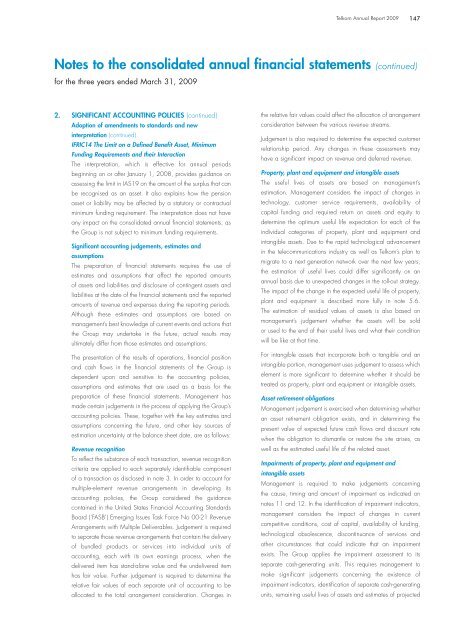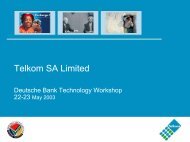Telkom AR front.qxp
Telkom AR front.qxp
Telkom AR front.qxp
Create successful ePaper yourself
Turn your PDF publications into a flip-book with our unique Google optimized e-Paper software.
2. SIGNIFICANT ACCOUNTING POLICIES (continued)<br />
Adoption of amendments to standards and new<br />
interpretation (continued)<br />
IFRIC14 The Limit on a Defined Benefit Asset, Minimum<br />
Funding Requirements and their Interaction<br />
The interpretation, which is effective for annual periods<br />
beginning on or after January 1, 2008, provides guidance on<br />
assessing the limit in IAS19 on the amount of the surplus that can<br />
be recognised as an asset. It also explains how the pension<br />
asset or liability may be affected by a statutory or contractual<br />
minimum funding requirement. The interpretation does not have<br />
any impact on the consolidated annual financial statements, as<br />
the Group is not subject to minimum funding requirements.<br />
Significant accounting judgements, estimates and<br />
assumptions<br />
The preparation of financial statements requires the use of<br />
estimates and assumptions that affect the reported amounts<br />
of assets and liabilities and disclosure of contingent assets and<br />
liabilities at the date of the financial statements and the reported<br />
amounts of revenue and expenses during the reporting periods.<br />
Although these estimates and assumptions are based on<br />
management’s best knowledge of current events and actions that<br />
the Group may undertake in the future, actual results may<br />
ultimately differ from those estimates and assumptions.<br />
The presentation of the results of operations, financial position<br />
and cash flows in the financial statements of the Group is<br />
dependent upon and sensitive to the accounting policies,<br />
assumptions and estimates that are used as a basis for the<br />
preparation of these financial statements. Management has<br />
made certain judgements in the process of applying the Group’s<br />
accounting policies. These, together with the key estimates and<br />
assumptions concerning the future, and other key sources of<br />
estimation uncertainty at the balance sheet date, are as follows:<br />
Revenue recognition<br />
To reflect the substance of each transaction, revenue recognition<br />
criteria are applied to each separately identifiable component<br />
of a transaction as disclosed in note 3. In order to account for<br />
multiple-element revenue arrangements in developing its<br />
accounting policies, the Group considered the guidance<br />
contained in the United States Financial Accounting Standards<br />
Board (’FASB’) Emerging Issues Task Force No 00-21 Revenue<br />
Arrangements with Multiple Deliverables. Judgement is required<br />
to separate those revenue arrangements that contain the delivery<br />
of bundled products or services into individual units of<br />
accounting, each with its own earnings process, when the<br />
delivered item has stand-alone value and the undelivered item<br />
has fair value. Further judgement is required to determine the<br />
relative fair values of each separate unit of accounting to be<br />
allocated to the total arrangement consideration. Changes in<br />
<strong>Telkom</strong> Annual Report 2009 147<br />
Notes to the consolidated annual financial statements (continued)<br />
for the three years ended March 31, 2009<br />
the relative fair values could affect the allocation of arrangement<br />
consideration between the various revenue streams.<br />
Judgement is also required to determine the expected customer<br />
relationship period. Any changes in these assessments may<br />
have a significant impact on revenue and deferred revenue.<br />
Property, plant and equipment and intangible assets<br />
The useful lives of assets are based on management’s<br />
estimation. Management considers the impact of changes in<br />
technology, customer service requirements, availability of<br />
capital funding and required return on assets and equity to<br />
determine the optimum useful life expectation for each of the<br />
individual categories of property, plant and equipment and<br />
intangible assets. Due to the rapid technological advancement<br />
in the telecommunications industry as well as <strong>Telkom</strong>’s plan to<br />
migrate to a next generation network over the next few years,<br />
the estimation of useful lives could differ significantly on an<br />
annual basis due to unexpected changes in the roll-out strategy.<br />
The impact of the change in the expected useful life of property,<br />
plant and equipment is described more fully in note 5.6.<br />
The estimation of residual values of assets is also based on<br />
management’s judgement whether the assets will be sold<br />
or used to the end of their useful lives and what their condition<br />
will be like at that time.<br />
For intangible assets that incorporate both a tangible and an<br />
intangible portion, management uses judgement to assess which<br />
element is more significant to determine whether it should be<br />
treated as property, plant and equipment or intangible assets.<br />
Asset retirement obligations<br />
Management judgement is exercised when determining whether<br />
an asset retirement obligation exists, and in determining the<br />
present value of expected future cash flows and discount rate<br />
when the obligation to dismantle or restore the site arises, as<br />
well as the estimated useful life of the related asset.<br />
Impairments of property, plant and equipment and<br />
intangible assets<br />
Management is required to make judgements concerning<br />
the cause, timing and amount of impairment as indicated on<br />
notes 11 and 12. In the identification of impairment indicators,<br />
management considers the impact of changes in current<br />
competitive conditions, cost of capital, availability of funding,<br />
technological obsolescence, discontinuance of services and<br />
other circumstances that could indicate that an impairment<br />
exists. The Group applies the impairment assessment to its<br />
separate cash-generating units. This requires management to<br />
make significant judgements concerning the existence of<br />
impairment indicators, identification of separate cash-generating<br />
units, remaining useful lives of assets and estimates of projected




